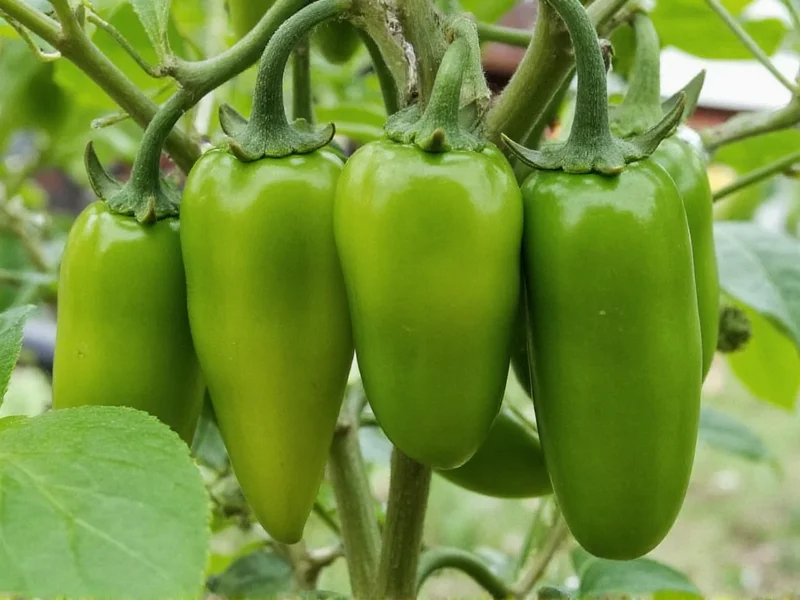Knowing precisely when to pick serrano peppers makes all the difference between enjoying their signature fiery kick and missing out on optimal flavor development. These slender chili peppers, scientifically known as Capsicum annuum, require careful timing to harvest at their peak quality whether you're growing them in your backyard garden or on a larger scale.
Understanding Serrano Pepper Maturity Stages
Serrano peppers progress through several distinct maturity stages, each offering different flavor profiles and heat levels. Unlike some chili varieties, serranos can be harvested at multiple points in their development cycle, giving growers flexibility based on their culinary needs.
The journey from flower to harvestable pepper typically takes 70-90 days, though this varies depending on climate, soil conditions, and specific cultivar. Understanding these stages helps determine the best time to pick serrano peppers for your particular application.
Key Visual Indicators for Harvesting
When determining how to tell when serrano peppers are ready, focus on these visual cues:
- Size: Mature serranos typically reach 1-4 inches in length and about 0.5-1 inch in diameter
- Color: Vibrant green indicates peak heat; transitioning to yellow, orange, or bright red signals increased sweetness
- Surface texture: Smooth, glossy skin without wrinkles or soft spots
- Stem connection: The stem should appear healthy and firmly attached
Unlike bell peppers, serranos don't require full color change to be edible. Most commercial growers and home gardeners harvest them while still green for that characteristic sharp heat profile between 10,000-23,000 Scoville Heat Units.
| Maturity Stage | Appearance | Heat Level | Flavor Profile | Harvest Timing |
|---|---|---|---|---|
| Immature | Pale green, thin walls | Mild (5,000-10,000 SHU) | Grassy, vegetal | Too early - not recommended |
| Optimal Green | Vibrant green, firm | Peak (15,000-23,000 SHU) | Sharp, clean heat | 70-80 days after planting |
| Transitioning | Yellow/orange streaks | Moderate (10,000-15,000 SHU) | Complex, developing sweetness | 80-85 days after planting |
| Full Red Ripeness | Bright red, slightly softer | Milder (8,000-12,000 SHU) | Sweet, fruity notes | 85-90+ days after planting |
Timing Your Harvest for Maximum Results
The optimal time to pick serrano peppers depends on your intended use. For traditional Mexican salsas and hot sauces where intense heat is desired, harvest when peppers reach full size but remain bright green. This typically occurs 70-80 days after transplanting seedlings outdoors.
For culinary applications requiring more complex flavor profiles, allow peppers to continue ripening on the plant until they develop red hues. The complete transition to red usually happens around 85-90 days after planting, though this varies by growing conditions.
Consider these timing factors when deciding when do serrano peppers turn red in your specific garden:
- Temperature: Warmer conditions accelerate ripening; cooler temperatures slow the process
- Sun exposure: Peppers receiving full sun mature faster than those in partial shade
- Water consistency: Irregular watering can delay color change
- Nutrient balance: Excess nitrogen promotes leaf growth over fruit development
Harvesting Technique Matters
Proper harvesting technique ensures continued production and plant health. Never pull serrano peppers from the plant, as this can damage branches and reduce future yields. Instead:
- Use sharp scissors or pruning shears for clean cuts
- Cut the stem about ¼ inch above the pepper's shoulder
- Harvest in the early morning when temperatures are cooler
- Handle peppers gently to avoid bruising the thin skin
- Wear gloves if sensitive to capsaicin oils
Regular harvesting actually encourages the plant to produce more flowers and subsequent fruit. When you pick serrano peppers promptly upon reaching maturity, the plant redirects energy to developing new peppers rather than ripening existing ones.
Consequences of Improper Harvest Timing
Understanding what happens if you pick serrano peppers too early helps avoid common mistakes. Immature peppers:
- Have significantly reduced heat levels
- Develop thinner walls with less flesh
- Offer less complex flavor profiles
- May not continue ripening properly off the plant
Conversely, leaving serranos on the plant too long results in:
- Overly soft texture that doesn't hold up in cooking
- Decreased heat as sugars develop
- Increased susceptibility to pests and diseases
- Reduced overall plant productivity as energy goes to seed production
Post-Harvest Considerations
How you handle serranos immediately after picking affects their shelf life and quality. For best results:
- Store harvested peppers at 45-50°F with 90-95% humidity
- Green serranos typically last 2-3 weeks in proper conditions
- Red-ripened serranos have a shorter shelf life of 1-2 weeks
- Do not wash peppers before storage to prevent moisture-related spoilage
- For long-term storage, freeze whole peppers or dry them for powder
Remember that serranos continue to develop heat for several days after harvest. If you've picked them at the optimal green stage but want slightly more intensity, store them at room temperature for 2-3 days before use.
Maximizing Your Serrano Pepper Yield
Implement these strategies for continuous harvest throughout the growing season:
- Practice selective harvesting by picking only mature peppers while leaving smaller ones to develop
- Maintain consistent soil moisture to prevent blossom end rot and promote steady fruit development
- Apply balanced fertilizer every 4-6 weeks to support ongoing production
- Monitor for pests like aphids that can stress plants and reduce yields
- In cooler climates, use row covers to extend the growing season
By understanding when to harvest serrano peppers at various maturity stages, you gain versatility in your culinary applications while maximizing your garden's productivity. Whether you prefer the sharp bite of green serranos or the complex sweetness of fully ripened red ones, proper timing ensures you get the most from your plants.











 浙公网安备
33010002000092号
浙公网安备
33010002000092号 浙B2-20120091-4
浙B2-20120091-4